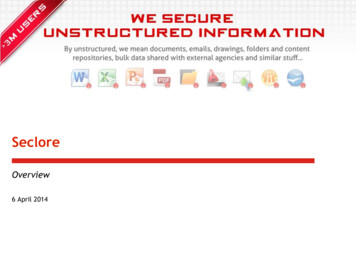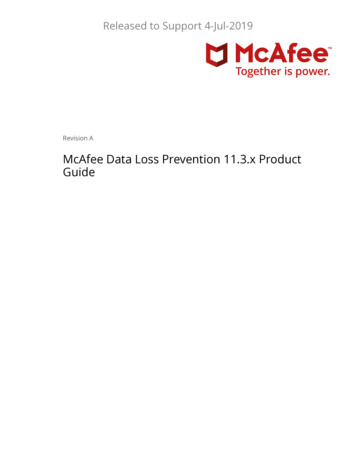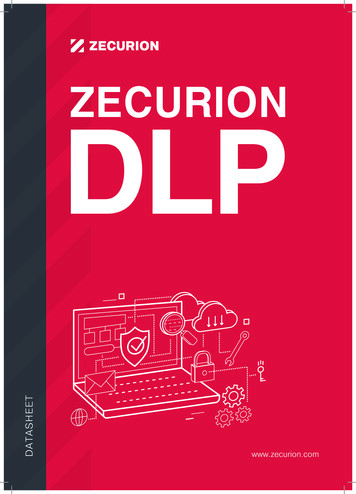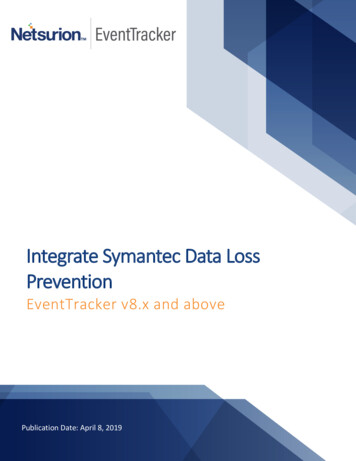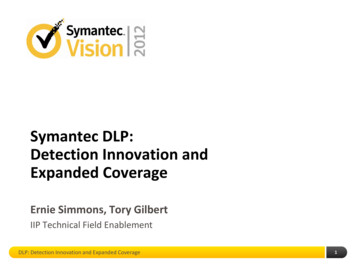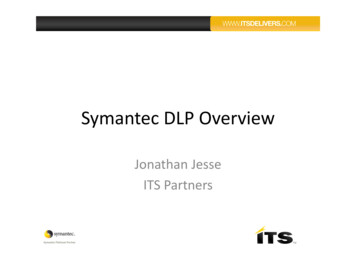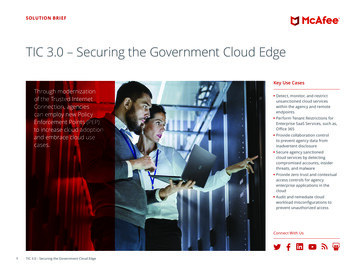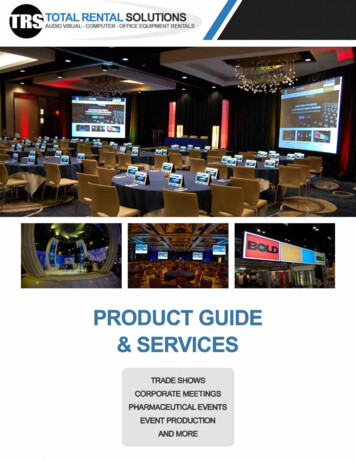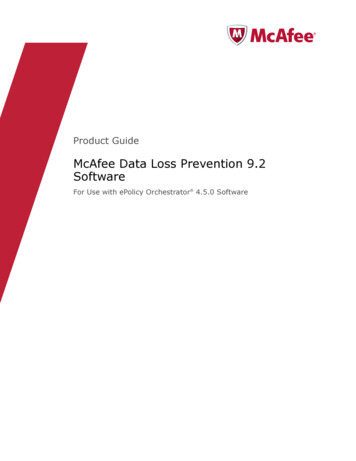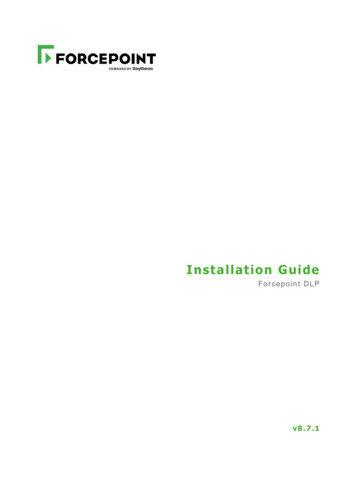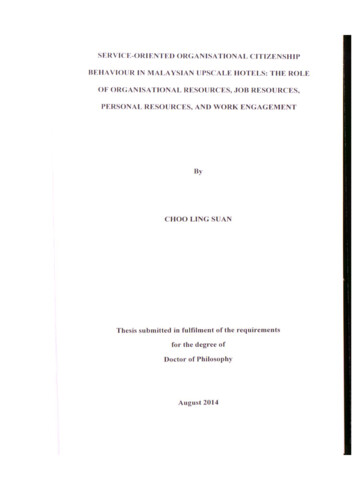
Transcription
SERVICE -ORIENTED ORGANISATIONAL CITIZENSHIPBEHAVIOUR IN MALAYSIAN UPSCALE HOTELS: THE ROLEOF ORGANISATIONAL RESOURCES , JOB RESOURCES ,PERSONAL RESOURCES , AND WORK ENGAGEMENTByCHOO LING SUANThesis submitted in fulfilment of the requirementsfor the degree ofDoctor of PhilosophyAugust 2014
AC KN ( W LHI )( FMKNTS.First and foremost I offer my deepest gratitude to my supervisor Professor Dr.Aizzat Mohd . Nasurdin who has guided me thoughout this thesis process. My progressis much more a testament of her efforts than my own . Without her guidance, I w ould nothave been able to complete this thesis.I would also like to thank my thesis examiners Associate Prof. Dr. Noor Hazlina''Ahmad . Dr. Hazril I / war Bin Ibrahim , Dato Ishak Ismail , and Pro!. Dr . RoselinaAhmad Saufi whose advice and insights have been invaluable to me . Thank you to alllecturers and administrative staff in the School of Management , especially Dr . Hasliza,Dr. Siti Rohaida, Dr. Amirul, Associate Prof. Quail, Tn . Nabil , En . Muhamad Ri /.al andEn . Md Noor who always greeted me with a friendly smile and gave me moral support.A note of thanks goes to a stimulating and fun group of fellow students at theSchool of Management 's PhD room : Theressa Ho, Adeline Chin . Comic Chong,Rayendra, Jasmine Yeap. Mohd . Nasir Selamat , Omari. Dudi , Pak Ajol , Sabai Kin ,Nastaran. Simon Kepong. Jeniboy, Mohd Akbal , Azlin , Nurul Liyana, and many otherswho always stood by me whenever I needed support , guidance and encouragement .Your attitude to research inspired me to continue to move forw ard in this journey.Light and love to my friends from the Ananda Marga Yoga society, especiallyBhadrika, Jinnaprakash , Vimala, Rashmi, Vimukti , Radhika, Sukanya, lista, Miira.Jayavanii, Surabhii, Kevala , Vinita , Hema , Rajesh . Locana. Shiilabhadra , Bohdi. DidiAnanda Mahduvidya , Didi Ananda Sampriija , Dada Manavendranananda and Dadau
Premamayananda, who have brightened many of my dull days, and inspired me tocontinue to move ahead on a spiritual path during the ups and downs in conducting myresearch . I would like to pay my eternal salutation to my beloved guru , Shirii ShiriiAnanda Murti whose teaching is my source of inspiration -1 dedicate this work to you .I gratefully acknowledge the human resource managers of the participatinghotels who have rendered invaluable help during my data collection . I am also indebtedto the respondents who were willing to spend time completing the survey and made thisstudy possible. My heartfelt thanks to Prof. T. Ramayah for devoting his time andenergy in conducting a PLS workshop that helped me in my data analysis. I also extendmy appreciation to Brother Jiivanesh and Ms . Jane who have willingly spent theirprecious time in proof- reading my thesis and giving valuable suggestions to improve it .I am thankful to USM s Institute of Postgraduate Studies for assisting me to'pursue my study financially by offering the fellowship scheme.I thank my parents for supporting me and believing in my decision . Their love isway beyond words.Last but not least , I must pay high regards to numerous visible and invisiblesouls that contributed in many w ays to the completion of this thesis.m
TABLE OF CONTENTSACKNOWLEIH; E M E NTSTABLE OF CONTENTSLIST OF TABLESLIST OF FIGURESLIST OF APPENDICESABSTRAKABSTRACTCHAPTER 11.01.11.21.31.41.51.5. 11.5 nBackground of the StudyProblem StatementResearch ObjectivesResearch QuestionsSignificance of the StudyTheoretical ContributionsPractical ContributionsDefinition of Key TermsSummary and Organisation of the Remaining Chapters1I816171819202226CHAPTER 2 LITERATURE REV IEW2.02.12.2IntroductionConceptualization of Organisational CitizenshipBehaviour ( OCB )Service-Oriented Organisational Citizenship Behaviour( SO-OCB )The Importance of Serv ice Oriented OrganisationalCitizenship Behaviour ( SO-OCB )Antecedents of Organisational Citizenship BehaviourOrganisational - Based VariablesJob- Based VariablesPersonal - Based Variables2.4 .3.1 Personality Trait2.4 . 3.2 Demographic Factors2.4 . 3.3 Attitudinal Factors-2.32.42.4 . 12.4 .22.4 .3IV2828303234354246464749
2.52.5 . 1*)n2.5.32.5.3.12.5 . 3.22.5 .3.32.5 . 3.42.62.6. 12.6 . 1.12.6 . 1.22.6. 1.32.6. 1.42.6 . 22.6 . 2.12.6 . 2.22.6 . 2.32.6 .32.6. 3 . I2.72.82.92.9. 12.9.22.102.1 12 . 1 1.12.11 .2Antecedents of Serviced )riented OrganisationalC itizenship Behaviour ( SO-OCB )Orga n isa t i ona I - Based V a r i ab I esJob- Based VariablesPersonal - Based VariablesPersonal dispositionIntellectual AbilityDemographic FactorsAltitudinal FactorsVariables Related to the StudyOrganisational - Based ResourcesService TrainingServ ice RewardsPerformance AppraisalInformation SharingJob- Based ResourcesRole ClaritySuperv isor SupportColleague SupportPersonal - Based ResourcesEmotional IntelligenceWork Engagement( iaps in the LiteratureUnderlying TheoriesConservation of Resources ( COR ) Theoryt he Job Demands- Resources ( JD- R ) ModelResearch FrameworkI lypothesesRelationship between organisational- based resourcespractices which( humanmanagementresourcecomprised serv ice training, service rewards, performanceappraisal, and information sharing ) and SO-OCB( loyalty OCB, serv ice delivery OCB, and participationOCB )Relationship between job- based resources ( role clarity,superv isor support , and colleague support ) and SO-OCB( loyalty OCB, service delivery OCB, and participationOCB 01103104108109111
2.1 1.3personal - based resourceswhich comprised self-emotionappraisal , others emotion appraisal , use of emotion ,and regulation of emotion ) and SO-OC B ( loyaltyOC B, service delivery ( X’B, and participation OCB )Relationship between organisational - based resources( H R M practices which comprised service training,rewards.performance appraisal , andserviceinformation sharing ), work engagement, and SO-OCB( loyalty OCB. serv ice delivery OCB, and participationRelationshipbetween1 13( emotional intelligence*2.1 1.42.1 1.52.1 1.62.12OCB )Relationship between job- based resources ( role clarity,supervisor support , and colleague support ), workengagement , and SO-OCB ( loyalty OCB, servicedelivery OCB, and participation OCB )The relationship between personal - based resources( emotional intelligence which comprised self-emotionappraisal , others' emotion appraisal, use of emotion,and regulation of emotion ), work engagement , and SOOCB ( loyalty OCB. service delivery OCB.participation OCB )SummaryI 15117119121C H A P T E R 3 METHODOLOGY3.03.13.23.33.43.53.5 . 13.5 . 23.5 . 33.5 . 43.5 . 53.5 . 63.5 . 73.5 . 83.5 . 9IntroductionResearch DesignPopulation and Sample SizeSampling TechniqueData Collection ProcedureResearch InstrumentsService-oriented OCBWork EngagementServ ice TrainingService RewardsPerformance AppraisalInformation SharingRole ClaritySuperv isor SupportColleague 7138
3.5. 103.63.73.83.8 . 13.8. 23.8 .33.8 .43.93.9 . 13.9. 23.103.10 . 13.10 . 23.1 1I motional IntelligenceTranslation of the QuestionnairePilot StudyData ScreeningMissing Data and OutliersCommon Method BiasTest of Non - Response BiasTest of DifferencesPreliminary AnalysisDescriptive StatisticsMeans and Standard Deviation of Study VariablesData AnalysisEvaluation of the Measurement ModelEvaluation of the Structural 48150154CHAPTER 4 DATA ANALYSIS AND RESULTS4.04.14.24.2 . 14.2 .24.2 .34.2 .44.34.3 . 14.3 . 24.44.4 . 14.4 . 24.54.5 . 14.5 .24.5 . 34.5 . 44.5 .54.5 . 64.6IntroductionResponse RateData ScreeningMissing Data and OutliersCommon Method Biasl est of Response and Non - Response Biasl est of DifferencesPreliminary AnalysisRespondents ' ProfileMeans Scores and Standard Deviation of the StudyVariablesAssessment of Measurement ModelIndividual Item Reliability and Internal ConsistencyConvergent Validity and Discriminant ValidityAssessment of Structural ModelAssessment of Control Variable EffectHypothesis Testing for Direct EffectHypothesis Testing for Mediation PathsVariance ExplainedPredictive RelevancyGoodness of FitSummary of 180180181187194195196197
CHAPTER 5 DISCUSSION AND CONCLUSION5.05.15.2IntroductionRecapitulation of the Study ' s FindingsDiscussion5.2 . 15.2 . 1.15.2 . 1.25.2 . 1.35.2 . 2.15.2 . 2.25.2 . 2.35.35.3 . 15.3 . 25.45.5T he Relationship between Resources and SO-OCBThe Relationship between Organisational - BasedResources and SO- OCBThe Relationship between Job- Based Resources and SOOCBThe Relationship between Personal - Based Resourcesand SO -OCBThe Indirect Relationship between Resources and SOOCB: The Mediating Role of Work EngagementThe Indirect Relationship between Organisational - BasedResources and SO- OCB : The Mediating Role of WorkEngagementThe Indirect Relationship between Job- Based Resourcesand SO-OCB: The Mediating Role of WorkEngagementThe Indirect Relationship between Personal - BasedResources and SO- OCB: The Mediating Role of WorkEngagementImplications of the StudyTheoretical ImplicationsPractical ImplicationsLimitations and Suggestions for Future 232232233238240243ReferencesVIIII
LIST OF TABLESPageFable 2.1Summary of Organisational - Based Variables and ( K B39Iable 2.2Summary of Job - Based Variables and45TableSummary of Personal- Based Variables and OCB52Summary ' of Organisational - Based Variables and SO- OC B58612.3Iable 2.4( )(BTable2.5Summary of Job - Based Variables and SO-OC Btable2.6Summary' of Personal Based Variables and SO-OC B-65Table2.7HRM Practices Studied in Previous Studies76Table3.1Distribution of Four - and Five- Star Hotels in Malay sia125Table3.2Summary' of the Estimated Population in this Study127Table3.3Summary of the Numbers of Participating Hotel in This Study128Table3.4Summary of Measurements Adapted in the Study131-Table 3.5Items Constituting SO OCB Scale132Table 3.6Items ( instituting the Work Engagement Scale133Table 3.7Items Constituting the Service Training Scale134Table 3.8Items Constituting Semite Rewards Scale135TableItems Constituting the Performance Appraisal Scale135Table 3.10Items C instituting Information Sharing Scale136I able 3.1 1Items Constituting Role Clarity Scale137Items Constituting the Supervisor Support Scale138Table 3.13 Items Constituting the Colleague Support Scale138Table 3.14Items Constituting Emotional Intelligence Scale139Table 3.15Revision of Items Based on Suggestions from Respondents inPilot Study141Table3.93.12ix
IFable3.16Summaryfor the Evaluation of the MeasurementIablc3.17Summaryof the Evaluation for the Structural ModelFable4.1The Distribution of Responding Hotels156Table4.2Response Rate157I able4.3Results of the Independent Samples t -test for Non ResponseBias on the Study Variable159Fable4.4Results of the Independent Samples t -test for Non- ResponseBias on the Respondent s Profile160Fable4.5Results'of ( ' hi -squareTestforModel150154Non- Response Bias on the160Respondent s ProfileFable4.6Results of the Independent t -test between Peninsular andEast Malaysia on the Study Variables162Table4.7Results of the Independent t - test between 4 and 5 Star - RatedHotels on the Study Variables163Table4.8Results of the Independent t - test between Front Office andFood & Beverage Department on the Study Variables164Fable4.9Results of the A NOVA betweenVariables165Different ResignationsonStudyTable4.10Respondent 's Profile169Table4.11Mean Scores and Standard Deviation for Study Variables171Table4.12Results of Items Reliability . Internal Consistency andConvergent Validity172Table4.13Correlations among Constructs175Table4.14Results of Items Reliability , Internal Consistency andConvergent Validity (re-initiated)176Fable4.15Correlations among Constructs ( Re- initiated )179Table4.16AssessmentofControl VariableVariablesxEffecton Endogenous181
Tabic4.17PathCoefficient forOrganisational Based Resources and’185SO-OC BTable4 . IXPath ( ' oe/ficient for dob - Based Resources and S( - ( )( B186Table4.19Path C Oe/ficient of Personal - Based Resources and S( )-( )C B187Table4.20PathC oe/ficientfor Mediation Path betweenOrganisational - Based Resources , Work Engagement andSO- OC B191Table4.21Path ( ’oe/ficient for Mediation Path between Job - BasedResources. Work Engagement and SC )- ( X B192Table4.22Path C ' oe/ficient for Mediating Path between Personal Based Resource , Work Engagement and SO-OC ' B193Table4.23R Values in the Model195Table4.24Predictive Relevancy for Endogenous Variable196Table4.25(Table4.26 Summary 'aleulation and Resultof Goodness of Fit (GoF) Indexof Hypotheses Findingsxi1961971
LIST OF FIGURESPageFigure 2.0Research Framework106Figure 3.1An Example of a Mediation Path152Figure 4.1Path Coefficients among Exogenous Variables and EndogenousVariables182F igure 4.2/- valuesFigure 4.3Path Coefficient for Mediation Pathsamong Exogenous Variables and Endogenous Variables183189iXII
LIST OK APPEND ICESPageAIntroduction Letter283BQuestionnaire2X5CMissing Values295I)Outliers301ECommon Method Bias321FIndependent / - test between Response and Non - Response Bias basedon study variables324GChi - square test for Non - Response Bias based on profile of therespondents328IIIndependent / - test between Responses from East and PeninsularMalaysia on study variables338Independent / - test between Responses from 4 and 5 Star Rated Hotelson the Study Variables341JIndependent / - test between Responses from Front Office and Food &Beverage Department on Study Variables344KANOVA between Different Resignations on Study Variables348LRespondents Profile351MMean Scores and Standard Deviation for Study Variables358NItem Reliability , Internal Consistency and Convergent Validity359OLatent Variable Correlations363PCross- Loadings for all Indicators364QItem Reliability, Internal Consistency and Convergent Validity. CrossLoadings ( Re-initiated )367RAssessment of Control Variables372*XIII
386S/ - valuesIPath C oefficients and /- values for Indirect Paths387UVariance Explained in the Model389VPredictive Relevancy390for Direct PathsXIV
GELAGAT KEWARGA NEGARAA N ORGANISA SI BERORIEN TASIKANPERKHID MATAN I) A LAM HOTEL BERSCAL A TINGGI 1 ) 1 MALAYSIA :PERANAN SUM HER ORGANISA SI , SUM HER PERKERJ AAN , SUMBERPERIBADI DAN KETERLI BATAN KERJAABSTRAKCielagat kewarganegaraan organisasi berorientasikan perkhidmatan ( SO-OCB ) adalahsatu bentuk gelagat kerja yang melebihi deskripsi kerja formal dalam organisasiperkhidmatan . Mengandungi tiga dimensi iaitu. OCB kesetiaan , OCB perkhidmatanpenghantaran. dan OCB penyertaan. SO -OCB adalah penting kepada organisasiberasaskan perkhidmatan seperti hotel bagi meningkatkan kualiti perkhidmatan dankesetiaan pelanggan . Berdasarkan kepada Conservation of Resources Theory, kajian inimeramalkan wujudnya hubungan positif dan signifikan di antara tiga asas sumber( organisasi ,pekerjaan , dan peribadi ) dengan SO -OCB . Sumber berasaskan organisasimerupakan amalanpengurusan sumber manusia yang terdiri daripada latihanperkhidmatan , ganjaran perkhidmatan , penilaian prestasi , dan perkongsian maklumat;sumber berasaskan kerja terdiri daripada kejelasan peranan , sokongan penyelia dansokongan rakan sekerja , manakala sumber berasaskan peribadi merujuk kepadakecerdasan emosi yang mengandungi penilaian emosi diri , penilaian emosi individulain , penggunaan emosi, dan kawalan emosi diri . Selain itu , dengan menggunakanelemen Job- Demands Resources Model, kajian ini mengandaikan bahavva hubungan diantara ketiga- tiga sumber tersebut dengan SO-OCB dapat dihubungkan melaluiketerlibatan kerja. Hubungan yang disarankan diuji berdasarkan analisis daripada 438soal selidik urns sendiri yang diperoleh daripada 34 hotel berskala tinggi di Malaysiaxv
mcnggunakan pcndckatan Partial least Squares. Daripada itu, dapat disimpulkanbahavva:(I ) di antara sumher berasaskan organisasi, hanya penilaian prestasi‘mempunyai hubungan positif dan signifikan dengan semua dimensi SO-OCB, manakalalatihan perkhidmatan dan perkongsian maklumat hanya meramalkan dimensi tertentu-dalam SO OCB;( 2 ) sum herberdasarkan kerja (kejelasan peranan dan sokonganpenyclia) hanya meramalkan beberapa dimensi dalam SO-OCB; (3 ) kebanyakandimensi kecerdasan emosi (kecuali penilaian emosi diri ) mempunyai hubungan positifdan signifikan dengan SO-OCB; dan ( 4 ) keterlibatan kerja menjadi pengantarahubungan dengan penilaian prestasi. kejelasan peranan, sokongan penyelia, penggunaanemosi, kawalan emosi diri dan SO-OCB. Hotel yang ingin meningkatkan SO-OCB.harus lebih fokus ke atas penilaian prestasi. kecerdasan emosi, sokongan penyeliakejelasan peranan dan juga keterlibatan kerja pekerja yang mempunyai hubungandengan pelanggan. Penyelidikan pada masa hadapan boleh merangkumi sumber dalambentuk lain bagi meningkatkan kefahaman mengenai keterlibatan kerja dan SO-OCB.xvi
SERVICE- ORIENTED ORGANISATIONAL CITIZENSHIP BEHAVIOUR INMALAYSIAN UPSCALE HOTELS: THE ROLE OF ORGANISATIONALRESOURCES, JOB RESOURCES, PERSONAL RESOURCES, ANI) WORKENGAGEMENTABSTRACTService- oriented organisational citizenship behaviour ( SO-OCB ) is a form of extra-rolebehaviour that goes beyond formal work descriptions in a service organisation .Consisting of three dimensions, loyalty OCB, service delivery OCB, and participationOCB, SO- OCB is important to service organisations, such as hotels in improving itsservice quality and customer loyalty. This study grounded in the Conservation ofResources Theory', posited a positive and significant relationship between three bases ofresources ( organisation, job. andpersonal ) and SO- OCB. Organisational-basedresources are HRM practices whichconsists of service training, service rewards,performance appraisal, and information sharing, job - based resources comprise roleareclarity, supervisor support, and colleague support, and personal - based resourcesemotionemotional intelligence, which consists of self- emotion appraisal, other sof theappraisal, use of emotion, and regulation of emotion. Also drawing on elementsbetweenJob-Demands Resources model, this study postulated that the relationshipsthethree bases of resources and SO-OCB are mediated by work engagement . Iestingquestionnairesproposed relationships was based on analysis of 438 self - administeredthis, itfrom 34 upscale Malaysian hotels using the Partial Least Squares approach. Fromcan be concluded that: ( I ) among theorganisational-based resources, only performanceof SO-OCB, asappraisal has a positive and significant relationship with all dimensionsxvnA
service training and information sharing only predicted certain dimensions in SO-OCB;(2)job- based resources ( role clarity and supervisor support ) only predicted severaldimensions of SO-OCB; ( 3 ) most of the dimensions of emotional intelligence ( exceptself-emotion appraisal ) had a positive and significant relationship w ith SO-OCB; and ( 4 ).work engagement mediated the relationship between performance appraisal , role claritysupervisor support, use of emotion, regulation of emotion and SO-OCB. Hotels w ishingtoimprove staff SO-OCB should focus on performance appraisal, emotionalintelligence, superv isor support, role clarity as well as work engagement of customer contact employees, future research could incorporate other forms of resources to shedmore light on the relationship of work engagement and SO-OCB.XVIII
CHAPI KK IINTROD UCTION1.0Introduc tionI his chapter discusses the background of the study, issues that are related to thehotel industry in Malaysia, research objectives, research questions, significance ofthe study , definitions of the key terms, summary , and organisation of the thesis.1.1Backgrou nd of the StudyAs the Malaysian economy develops and the nation moves towards its goal ofbeing a developed nation , the services sector begins to assume a greater role. In'2012, the services sector contributed 54.6 percent of Malaysia s Gross DomesticProduct ( GDP ) , and is forecast to reach 65 percent by 2020 ( Ministry of InternationalTrade and Industry, 2013 ) .In terms of tourism, Malaysia was the ninth most visited country in the worldin 201 I ( Grossniklaus, 2013 ), making it one of the most dynamic economic services, and Raquibsectors within the service industry. According to Mazumder. Ahmed( 201 1 ) the tourism industry creates a high multiplier effect and.enhances inter -sectordirectlylinkages to Malaysia ' s economy. In addition, tourists’ expenditure not onlyestate, andbenefits tourism related sectors, but also others sectors such as retail, realon towine and soft drinks ( Mazumder et al „ 2011 ). In terms of the contributias much as 7.6Malaysia ' s CiDP, revenue from the tourism industry has contributedUnit , 2012 ) . Thispercent in 2010, up from 6.1 percent in 2005 ( Economic Planning
contribution was attributedtothe rise in inbound tourist arrivals and tourist receipts.I he arrival of tourists soared from 16.43 million in 2005 to 25.72 million in 2013( lourism Malaysia, 2014 ) . In accordance to this, tourist receipts rose from RM32billion in 2005tostand at RM65.44 billion in 2013 ( Tourism Malaysia, 2014 ).Recognizing the potential in tourism, the Malaysian government has listedthe tourism industry as one of the industries in The New Key Economic Area( NKEA ),h Malaysia Plan ( 201 1 -2015 ).under the 10Within this five-year plan, theMalaysian government is targeting to place Malaysia to be w ithin the top 10 in termsof global tourism receipts with the estimated arrival of 36 million tourists andRMI 15 billion in global tourist receipts ( Economic Planning Unit, 2010 ) . To realizetnthe 10 Malaysia Plan, the focus of Malaysia government is to attract a larger share.of high -end travellers and on capturing a higher share of the high-traffic segmentsalparticularly from Russia. India. China and Middle East ( Ministry of InternationI rade and Industry, 201 I ) .KhooI he hotel sector is a critical part of the tourism industry (Ekiz.) . Data fromLattimore, & Memarzadeh, 2012; Zailani, Hj Din, & Abd Wahid, 2006in tourism2007 to 2010 show that accommodation is the most important elementot totalreceipts. Particularly, accommodation takes up approximately 31 percentto the broadertourist spending ( Tourism Malaysia. 2011 ). Extrapolating thisRinggit spent byeconomy Mazumder et al ( 201 I ) demonstrated that one additional.of householdinbound tourists in hotels and restaurants would generate RM0.848458income toMalaysian residents. In the same study, Mazumderetal. ( 201 1 ) reportedhighest multiplierthat the income from the hotels and restaurants sectors has theeffect compared to other tourism related sectors.2
1 support the increase in tourist arrivals, there has been rapid developmentand construction of hotels in Malaysia. I he number of hotels in Malaysia increasedfrom 22% units in 2005 to 2724 units in 2012 ( Tourism Malaysia, 2014 ). Thenumber of rooms increased from 155,356 units in 2005 to 195,445 units in 2012( lourismMalaysia, 2014 ). Market analysts are expecting that the number ofMalaysian hotels will grow at therate of4 percent over 2014 ( Grossniklaus, 2013 ).I he increasing number of hotels and rooms has intensified competition for marketshare, since customers now have more choice, they want better value for money, anddemand a higher level of service ( Kandampully & Suhartanto, 2000 ).As hotels are service oriented organisations, they offer less tangible products-than many other industries (Ip. Lee, & Law. 2012 ). In striving to differentiateofthemselves from their competitors, hotels are often constrained by the limitationforstrategies ( Kandampully & Hu, 2007 ) . Generally, the strategies hotels adoptdiscounting,competitive advantage are either, ( I ) low cost leadership through priceor ( 2 )thatdeveloping customer loyalty. Scholars opt for the later strategy givenat risk inprice-reduction strategy reduces hotel income and puts hotel profitability, developing customerthe long-run ( Kandampully & Suhartanto, 2000 ). Alternativelyloyalty brings more benefittothe hotels and guests. Reichheld and Sasser ( 1990 )25reported that every five percent increase in customer loyalty equalsto85 percentd that developingincrement in profitability. In addition. Dolors ( 2012 ) suggestecustomerloyalty is a strategy more suitedto theservice industry given that services. Hence, it is better toroffer more opportunities for such development to take placethe hotelstodiscountingdevelop their customer loyalty than relying on priceabundance of empiricalstrategies. Accordingly, in developing customer loyalty, anquality is the prevailingstudies have evidenced that providing outstanding service3
point ( ( hen & llu. 2012 ; Chu, Lee, & Chao, 2012; Dolors, 2012; Kandampully &I lu, 2007; Lee. Lee, & Kang, 201 lb; MaQu, 201 I ).I he success of the hotel industry is therefore reliant on its service quality.( AminYahya, Ismayatim, Nasharuddin, & kassim, 2013; Ariffin, Nameghi, &/akaria. 2013 ). In particular, service quality among upscale hotels has become aprevailing issue given that the tourism ministry of Malaysia is targeting highspending tourists to realize the goal to be in top 10 of global tourism receipts( LconomicPlanning Unit, 2010 ). To achieve this aim, the Chairman of MalaysiaTourism Promotion Board, Datuk Dr. Victor Wee, called upon Malaysian hotelsto,boost their service quality in order to attract high -spending customers ( Wong & Lim2011 ). Nevertheless, in a study that examined customers perceptions of service'that thequality in Malaysian upscale hotels, Lau. Akhbar, and David ( 2005 ) revealed'ons.service quality in Malaysian upscale hotels is still below customers expectatistaff, slowAmong the common complaints made about upscale hotels were arrogantfood service and check - in/out, failure to respondto customersfood served in restaurants, wrong billing, and so on (Ekizetcomplaints, wrongal., 2012). To address'to improve theirthese shortcomings, scholars have urged upscale hotel s operators& Lluei, 2014 ) . Inservice quality ( Ekiz et al., 2012; Lau et al., 2005; Liat. Mansori.hotels has alarmedsummary, the poor service quality offered by Malaysian upscaleresults in negativehotel authorities and scholars, f ailing to provide quality servicesthe number of hotelsword-of-mouth and poor customer loyalty, which reducesguests and the hotel withers away andfinally exits the market ( Nik Mohd Masdek.Abdul Aziz, & Awang, 201 1 ).4
Hotels are a highly labour - intensive industry , with a wide range ofservicestall interacting with and serving hotel customers ( Ilanzaeea & Mirvaisib, 2013 ;Mcdlik , l ( 04 ; OT allon & Rutherford , 2010 ) . lo a certain extent , hotel staff, or'human resources, have been regarded as the hotel s “software" ( Qiu & Lam , 2004 ).'"Scholars are of the opinion that hotels must capitalize on its ‘ software to reachlevels of service quality expected by its guests ( Hayes & Ninemeier, 2009;Maroudas. Kyriakidou , & Vacharis, 2008 ; Nik Mohd Masdek et al., 2011 ).-Specillcally , for service organisation such as hotels, its customer contact employees;are serving as the referral point for its customers ( Nik Mohd Masdek et al . 201 IYavas, Karalepe, & Babakus. 201 la ) , acting as the first and primary contact between,the organisation and customers ( N i k Mohd Masdek et al . , 2011 ; Wang. 2009 b ) andhave frequent face- to- face or voice -to- voice contact with customers (Chang. Gong.& Shum , 2011 ; Nik Mohd Masdek et al . 2011 ). As such , customer -contactto elevateemployees are the most crucial human resources in hotels that could helpet al.hotel service quality ( Di Mascio 2010 ; Karatepe, 2013; Nik Mohd Masdek.2011 ; Yavas et al., 201 la ; Yeh. 2013 ).that placeGiven the critical role of customer -contact employees, hotels, especially extra - rolegreater attention in managing customer contact behaviours-in turn establishes,behaviours, are likely to achieve better service quality whichhas suggested that thestronger customer loyalty . In particular, previous literatureemployees have adiscretionary and extra - role behavioural of customer -contactquality ( Bienstock ,remarkable positive impact on customer's perception of service) termed these extra (DeMoranville, & Smith. 2003; Morrison , 1996 ). Organ 1988labelled as OCF3) ,(role behaviours as organisational citizenship behaviour hereafter5
and defined 0( 11 as discretionary behaviours that have a significant, positive impacton organisations but fall outside of the formal role of an employee.Consistent with Organ' s ( I 9KK ) reporting of OCB discretionary behaviours,Bettencourt. Ciwinner. and Meuter ( 2001 ) hold that service-oriented organisationalcitizenship behaviours ( hereinafter labelled as SO-OCB) are a more appropriatemeasure of OCB for customer -contact employees. The construct of SO-OCB termed.by Bettencourt ct al . ( 2001) consisted of three dimensions, namely loyalty OCBservice delivery OCB. and participation OCB. In loyalty OCB, customer-contactemployees act as the advocateto promotethe products, services and the positiveimage of the service organisation to customers. In service delivery OCB. customercontactemployees behave in a conscientious manner in performing their duty. Inparticipation OCB. customer -contact employees take the initiative to communicate tothe organisation and co- workers on how to enhance their service delivery.Another researcher, Wang ( 2009b) acknowledged that the three dimensionsfor customerof SO-OCB conceptualized by Bettencourt ( 2001 ) are more suitablecontactisemployees in the service organisation than other measures of OCB. Thisthe servicebecause customer -contact employees are the primary interface betweenonorganisation and customers and they represent the service organisatitodeliver theof SO-OCBservices to its custome
(emotional intelligence which comprised self-emotion appraisal, others' emotion appraisal, use of emotion, and regulation ofemotion), work engagement, and SO-OCB (loyalty OCB. service delivery OCB. participation OCB) Summary 1 3 14 I 5 1 5 7 2.11.6 9 2 1 R 3 Y Introduction 3 Research Design Population and SampleSize SamplingTechnique Data .

